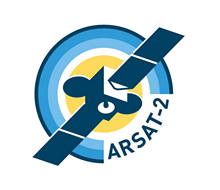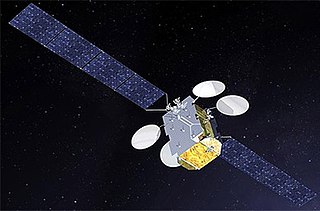Related Research Articles

Spacebus is a satellite bus produced at the Cannes Mandelieu Space Center in France by Thales Alenia Space. Spacebuses are typically used for geostationary communications satellites, and seventy-four have been launched since development started in the 1980s. Spacebus was originally produced by Aérospatiale and later passed to Alcatel Alenia Space. In 2006, it was sold to Thales Group as Thales Alenia Space.

The Arab Satellite Communications Organization is a communications satellite operator in the Arab World, headquartered in the city of Riyadh, Saudi Arabia. Arabsat was created to deliver satellite-based, public and private telecommunications services to the Arab States, in accordance with International Standards. With 21 member countries, the organization plays a vital role of enhancing communications in the Arab World.
Türksat is the name of a series of Turkish communications satellites operated or projected by the state-owned Türksat A.Ş.

Nilesat is an Egyptian company and the name of a series of Egyptian communications satellites. It was established in 1996 with the purpose of operating Egyptian satellites and their associated mission control center and ground stations. The company is owned by the Egyptian Radio & Television Union with a 40 per cent share, the Arab Organization for Industrialization with a 10 per cent share, the Egyptian Company for Investment Projects with a 9 per cent share and the rest is owned by the general public, Egyptian financial institutions and other investors. The company has two ground stations, a primary one in 6th of October City and a secondary ground station in Alexandria. The two ground stations were built by EADS Astrium. Nilesat operates multiple geosynchronous communications satellites, all of which are stationed at 7 degrees West. Nilesat includes as of 17 April 2022 1091 video channels, most of which are free-to-air.
Embratel Star One is a Brazilian communication satellite company. It is a subsidiary of Embratel.
Star One C1 is a Brazilian communications satellite. It was launched on 14 November 2007 by an Ariane 5ECA carrier rocket, as part of a dual-payload launch with Skynet 5B. It was built by Thales Alenia Space, based on the Spacebus-3000B3 satellite bus. It is operated by Star One, a subsidiary of Embratel.
Horizons-2 is a Ku band communications satellite owned by Horizons Satellite, a joint venture between SKY Perfect JSAT Group and Intelsat. Its orbital slot is located at 74° west longitude.
Türksat 3A is a Turkish communications satellite, operated by Türksat. It was constructed by Thales Alenia Space, based on the Spacebus 4000B2 satellite bus, and was launched by Arianespace atop an Ariane 5ECA launch vehicle, along with the British Skynet 5C satellite, in a dual-payload launch on 12 June 2008 at 22:05:02 GMT, from ELA-3 at the Guiana Space Centre in Kourou, French Guiana.
Nilesat 201, is an Egyptian communications satellite, which was launched on 4 August 2010.
Thaicom 5 was a geostationary communications satellite operated by Thaicom. It was used to provide communications services to Asia, Africa, Middle East, Americas, Europe and Australia.
Palapa-D was an Indonesian geostationary communications satellite which was operated by Indosat Ooredoo. It was built by Thales Alenia Space, based on the Spacebus-4000B3 satellite bus, and carries 35 C-band and 5 Ku-band transponders. It was positioned in geostationary orbit at a longitude of 113° East, where it will replace the Palapa-C2 satellite.
Eutelsat 21B, previously known as Eutelsat W6A, is a French communications satellite. Operated by Eutelsat, it provides direct to home broadcasting services from geostationary orbit at a longitude of 21.5 degrees east. It replaced the Eutelsat 21A spacecraft which was launched in 1999.
Yamal-402 is a Russian geostationary communications satellite. It was launched on 8 December 2012, 13:13:43 UTC from Site 200/39 at the Baikonur Cosmodrome in Kazakhstan. It was built by Thales Alenia Space, and is based on the Spacebus-4000C3 satellite bus. It is equipped with 46 Ku-band) transponders. It has a design life of 15 years, but reducing to 11 years expected after launch partial failure.
Yamal-401 is a Russian geostationary communications satellite operated by Gazprom Space Systems. It was built by ISS Reshetnev and is based on the Ekspress-2000 satellite bus. It is equipped with 17 C-band and 36 Ku-band transponders. It has a design life of 15 years.

ARSAT-2 is a geostationary communications satellite operated by ARSAT and built by the Argentine company INVAP. It was launched from French Guiana alongside Sky Muster satellite using an Ariane 5ECA rocket on September 30, 2015 at 20:30hs UTC, becoming the 400th satellite to be launched by Arianespace. It is licensed to be located at 81° West longitude geostationary slot. ARSAT-2 is the second geostationary satellite built in Argentina, after ARSAT-1. Structurally and mechanically it is a copy of the ARSAT-1, the only difference being the payload and thus it has different antenna configuration.
Yamal-601 is a Russian geostationary communications satellite ordered by Gazprom Space Systems from Thales Alenia Space (TAS) on the Spacebus-4000C4 satellite bus for its Yamal programme. The satellite has mass of 5,422 kg (11,953 lb) and 11 kW of payload power with over 15 years of design life. Its payload was also supplied by Thales Alenia Space and is composed of 38 C-band and 32 Ka-band transponders. It replaced Yamal-202 on 49° East as Yamal-202 was slated to reach its end of service around 2019.
Eutelsat 8 West B is a geostationary communications satellite. Operated by Eutelsat, it provides direct-to-home (DTH) broadcasting services from geostationary orbit. The satellite is part of Eutelsat's constellation at a longitude of 13° East. Eutelsat announced the order of a new Spacebus-4000C3 satellite bus from Thales Alenia Space in October 2012.
The Geostationary Defense and Strategic Communications Satellite or SGDC is a Brazilian geostationary communication satellite that was built by Thales Alenia Space in France, it was placed in the orbital position of 75 degrees west longitude and will be operated by Telebrás. Telebrás selected Viasat as a partner to help build the associated ground system. The satellite was based on the Spacebus-4000 platform and its life expectancy will be 18 years.

Eutelsat Konnect is a geostationary communications satellite operated by Eutelsat. The satellite was designed and manufactured by Thales Alenia Space on the Spacebus NEO 100 platform, and was launched on 16 January 2020 on an Ariane 5 ECA. The satellite provides broadband internet and communications coverage to Europe and Sub-Saharan Africa.
STENTOR was a French communications satellite which was lost in a launch failure in 2002. Intended for operation by CNES, France Telecom, and Direction générale de l'armement (DGA). To validate, in flight, advanced technologies which would be integrated in the next generation of telecommunications spacecraft. It will also demonstrate new telecommunications services, including broadband and multimedia transmissions to small user terminals.
References
- "Arianespace to launch pan-African satellite Rascom 1". Satellite Today. 27 October 2008.
- "Transfer of the pan African satellite Rascom-QAF1 to its launch site in French Guiana". Space Fellowship. 5 November 2007.
- "Newly-launched satellite beset by major problem". SPACEFLIGHT NOW - 6 February 2008.
- ↑ "Sixth successful Arianespace mission in 2007: RASCOM-QAF1 and Horizons-2 in orbit". defense-aerospace. Archived from the original on 2016-03-11. Retrieved 2016-03-08.
- ↑ "RASCOM-QAF1's Launch Early Operation Procedures have been stopped". Thales Alenia Space. Archived from the original on 2012-05-24.
- ↑ "New step in RASCOM-QAF1's Launch Early Operation Procedures". Thales Alenia Space. Archived from the original on 2012-05-24.
- ↑ "RASCOM-QAF1 satellite injected in final geostationary orbit". Thales Alenia Space. Archived from the original on 2012-05-24.
- ↑ "Newly launched satellite beset by major problem". SPACEFLIGHT NOW - 6 cFebruary 2008.
- ↑ "Thales Alenia Space to supply RASCOMSTAR-QAF with a new telecommunication satellite". Spacedaily.com. 11 September 2008. Retrieved January 2, 2023.
- ↑ "Successful launch for Rascom-QAF1R and Nilesat 201". Thales Group. 5 August 2010. Archived from the original on 8 March 2016. Retrieved 8 March 2016.